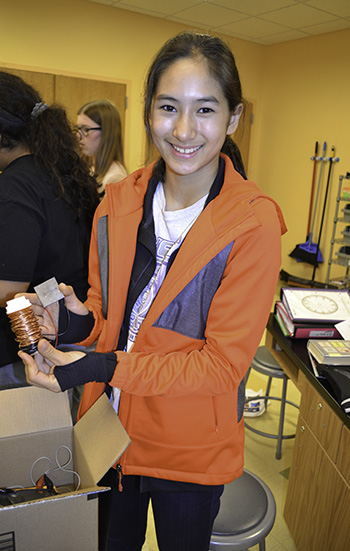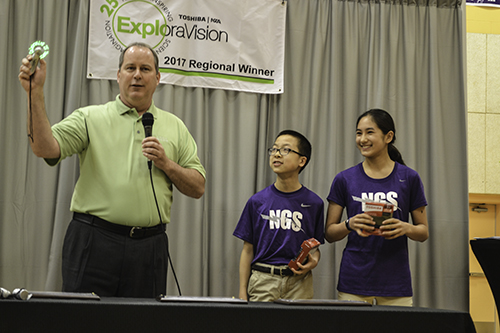Local Youths' Renewable Energy Invention Propels Them to the Regionals in Toshiba’s ExploraVision Contest*

Lawrence Zhao and Dina Hashash with the plaques they received from Toshiba at the awards ceremony.
April 20, 2017
One doesn’t have to be an adult to be an inventor. Nor does one have to be an adult to be Green. Dina Hashash and Lawrence Zhao, two local 7th graders at Next Generation School in Champaign are doing their part to promote renewable energy in order to help solve the energy crunch. As part of ExploraVision, Toshiba’s K–12 program designed to “engage the next generation in real-world problem solving, with a strong emphasis on STEM,” the two invented the BioKT. It's a watch-like device that harvests both kinetic and thermal energy from the body of its wearer. Their innovative design helped them reach the Regionals of the contest, an achievement celebrated by an awards ceremony at their school on April 13th.
On hand to present awards and gifts to both Dina, Lawrence, and their Middle School Science Teacher, Bryant Fritz, for his classroom, was Kennedy Cross, a senior district sales manager in the Toshiba America Business Solutions division out of Chicago. Cross says ExploraVision started in 1992 with 500 entries, but has grown to around 5000 entries every year, with only about 24 teams making it to semifinals.

Left to right: Kennedy Cross and Bryant Fritz, while Cross addresses the students, parents, and teachers during the awards ceremony.
Cross calls Toshiba’s contest a corporate social responsibility that “teaches kids that there are no boundaries within science, technology, and mathematics, and as a kind of way to jumpstart them into understanding that. Then when they do, we are rewarding them for their great ideas, and hopefully inventions.”
So last summer, Dina and Lawrence decided they wanted to participate. Since ExploraVision participants were to envision what technology might be like 20 years from now, the two started brainstorming, “bouncing ideas off each other for what problems we can fix in the world,” explains Dina. Some of their rejected ideas? Headaches. “Both of us suffer from that,” Lawrence admits. “My grandfather needs hearing aids, so we considered possibly improving hearing aids.” Then Dina’s dad suggested trying to solve the world’s increasing need for renewable energy. That piqued their interest.
“We were thinking about the growing need for energy that we are facing now,” says Dina. Knowing that most energy comes from fossil fuels or coal, they decided to target a renewable energy resource “that would completely eliminate the need for coal and other fossil fuels,” she continues. After considering the sun and plants, then came up with the human body, “because it is always accessible to us,” Dina explains. “And our human body actually lets off a lot of energy in forms that we usually don’t think of when we think of energy. But it is there. So our product focuses on thermal energy in the form of heat that comes off of our body and kinetic energy that comes off of our body when we move. So that’s how we developed BioKT.”

CAD-generated image of the BioKT.
BioKT is a watch-like device that’s a few millimeters thick and is very light. It not only it harvests thermal energy from heat that comes from your skin and kinetic energy when you move, but it’s also waterproof.
Some of the broader fields or topics the two explored included chemistry, biology, 3D modeling, thermoelectric energy, capacitors, and batteries. Some of the more specific areas, including some cutting-edge technology, included: kinetic and thermal harvesters, super conductors, aluminum graphite batteries, lithium salts, and carbon nanotubes.
“We basically covered the entire field of energy,” says Lawrence. How does their BioKT watch absorb thermal energy? According to Lawrence, it uses an effect that produces voltage from the temperature difference of a person’s body and the air. “So the colder it is outside, the more voltage you produce. So it would produce more voltage in the winter because the temperature difference is greater,” he explains. One caveat: it won’t work as well in the summer. But that’s when the kinetic energy harvester ostensibly kicks in, when one is probably more active. “If something goes wrong with one, the other one can take over,” Lawrence explains.
 A close-up image shows the various components of the BioKT.
A close-up image shows the various components of the BioKT.Dina explains what happens to the energy their device harvests: “So when the energy is harvested with the kinetic and thermal harvester, it is transferred using super conducting wires into an aluminum graphite battery. And this battery consists of an aluminum anode and a graphite cathode separated by lithium salts, and features carbon nanotubes that increase how much energy it can hold.”
So how is it that seventh graders know about cutting-edge technology, casually tossing around high-tech jargon like superconductors and nanotubes? Primarily through the internet.

Dina exhibits some of their designes the two are sending to Toshiba.
“It took a lot of research, but we were able to get to the final project. We went through website resources and book resources in the library. And we just read a bunch about batteries and energy harvesters, and that’s how we came up with that idea. But it was a lot of research and a lot of work to get to this.”
And once energy is stored in the battery, it can be used to charge any electronic device of your choice. Here's a scenario: suppose you’re out running around and discover that your phone is down to 3%. Can you charge your phone on your BioKT? Lawrence says yes.
“The purpose of the battery is to store for later use. So when you plug in the phone to the watch, it has a really fast discharge rate. So it lets go of all the energy and discharges it to your phone in like thirty seconds.”
And while their watch currently only has a USB port, being tech visionaries, the two foresee wireless charging down the road, “In the future there might be wireless charging which uses electromagnetic pulse from induction,” Lawrence explains. “So we might consider that. And that might be an alternative to plugging it in to a USB.”

Left to right: Lawrence Zhao, Dina Hasash, Kennedy Cross, and Bryant Fritz during the awards ceremony.
So someday, when you’re jogging, and discover that your i-phone is running on fumes, you might be able to go into your settings and tell it to recharge wirelessly—through your BioKT, of course.
How efficient is their invention? According to Lawrence, they haven’t as yet tried to measure how much energy they’ve harvested in a given time period: “We haven’t because it depends on the conditions of the weather. There are a lot of factors to consider.”
While neither of the two acknowledge pursuing something like this as a career down the road (Lawrence says, “Maybe, I’m not sure”), they evidently don’t see the project as just a one-time deal, either. For one, they envision improvements:
“So our thermal harvesters right now are not as efficient as we would like them to be,” Dina admits. “Right now they lose heat, and we don’t want that, so we have to perfect that.”
Another thing that might be in the works down the road is a patent. “Lawrence and I might further continue with this idea and hopefully prototype this," says Dina, “and maybe we can get this commercially available, but that’s something that we will have to wait and see.”
And should they win the ExploraVision contest, according to Cross, they’ll get lots of help from Toshiba in this area. “We do everything we can to help them take their ideas to market. And if they do win the national championship, we actually have a meeting with the patent department to discuss how to go about patenting their ideas, and making it a viable, sellable product.”
And that’s one thing the two are hoping for in the not-too-distant future—to become national finalists in ExploraVision. They’ll find out on May 7th whether or not they are. If they make the final cut, and become finalists, they will receive a $5000 savings bond, and they and their family will be flown to Washington, DC for the finals the first week of June.

During the awards ceremony, Lawrence Zhao and Dina Hasash applaud their parents for their support in allowing them to go after their dream.
“We want to make this a family event,” says Cross. “We put them up in a very nice hotel. It is a Thursday night to Sunday. We’ll even have Bill Nye the Science Guy.” As part of the event, on Saturday they’ll do a day of interviewing with TV affiliates all across the country, hosted by Bill Nye. Then the weekend will conclude with a formal dinner, attended by the Prime Minister of Japan as well as the chairman of the Toshiba foundation. “It’s a very elaborate, formal, and prestigious dinner that they have to announce the great efforts that they have done,” Cross explains.
And, as if the two students needed additional incentive, first place winners each get a $10,000 savings bond.

During a speech at the awards ceremony, NGS science teacher Bryant Fritz (right) affirms Lawrence and Dina for their initiative and creativity during the contest.
“It’s really a potentially exciting thing,” admits Bryant Fritz, “thinking about if they get to that point.”
One of the dynamic duo’s biggest fans, Fritz says that when the two approached him about the contest, he knew they had what it takes to do well.
“Dina and Lawrence are two of the students that I have who are really willing to push their interest in science and engineering. And so I knew that when they came to me, the level of work ethic and the amount of passion that they would put into the project would give them the opportunity to be successful.”
He also stressed that while he was delighted to be involved, he “really didn’t do very much. Dina and Lawrence did most of this on their own, and that’s something I really want to stress."
 Kennedy Cross presents a gift to Lawrence Zhao and Dina Hashash along with their plaques.
Kennedy Cross presents a gift to Lawrence Zhao and Dina Hashash along with their plaques.Head of School Chris Bronowski shares some of the benefits her students gained by participating in the project. For one, she says, “It kind of helped them have a really big challenge presented to them, and showed them that they can rise to it. And it took a lot of organization and thought into how they were going to accomplish the things that they did. And it’s also facing some fears and some unknowns, and sorting all that out… I think this was a great opportunity for them.”
Dina agrees: “It really opened our eyes to things we didn’t see before and how things will look like 20 years from now, and it was an amazing opportunity for us to learn.”
*LATE BREAKING NEWS FLASH: Next Generation's Lawrence Zhao and Dina Hashash WON the National Competition...This nets them each a $10,000 prize, plus a meeting with the patent folks at Toshiba!
Story and photographs by Elizabeth Innes, Communications Specialist, I-STEM Education Initiative.
For further information regarding Next Generation School, see these additional I-STEM articles:
- At NGS' Science & Engineering Fair 2017, Every Student Is a Winner!
- NGS Middle Schoolers Build Bridges, Experience Engineering During EOH Design Contest
- At NGS' Science & Engineering Fair 2017, Every Student Is a Winner!
- Next Generation Preschool's Grazi Murad Imparts Love of Science, Animals to Students
More: 6-8 Outreach, Next Generation School, 2017

Left to right: Kennedy Cross, Lawrence Zhao, Dina Hasash, and Bryant Fritz with the many awards and prizes Lawrence, Dina, and Mr. Fritz received from Toshiba.













.jpg)
















